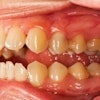Dental microwear is an important basis for understanding the diets of fossil mammals, including those of our own lineage.
Now a new study of worn tooth surfaces has found that quartz dust was a significant cause of enamel wear (Journal of the Royal Society Interface, January 9, 2013). In particular, East African hominins may have suffered during dust storms, particularly from particles carried in by seasonal winds from the Arabian peninsula.
To show this, researchers from the Max Planck Institute for Evolutionary Anthropology mounted single particles on flat-tipped titanium rods and slid them over flat tooth enamel surfaces at known forces. They found that quartz particles could remove pieces of tooth enamel at extremely low forces, meaning that even during a single bite, these particles could abrade much of the surface of the tooth if they are present in numbers.
The results could change scientists' understanding of how microwear reflects dietary habits, according to an article at Phys.org. Particles in dust storms, droughts, and other environmental factors may be more impactful than diet. However, elsewhere in the study, researchers found that plant phytoliths, or fossilized plant remains, were able to make cosmetic indentations in enamel that did not remove enamel.















